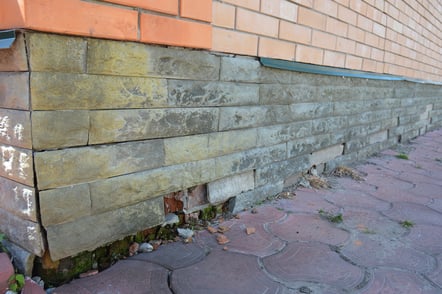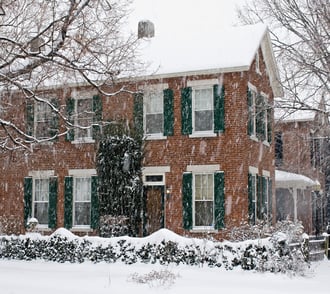Many love the appearance of icicles hanging along the eaves of an old house, but those icy formations mean something ominous is also forming on your roof – ice dams. Freezing weather and plenty of snow lead to ice dams that can damage gutters and shingles and cause water intrusion. And there is nothing more damaging than water seeping into your home.
An ice dam is a ridge of ice that freezes on your roof’s edge and stops the free drainage of water as snow melts. Water backs up behind this dam and takes the path of least resistance – underneath shingles and into your home. This water will cause peeling wall paint, sagging ceilings, water stains, warped floors, sodden overhead insulation, and dangerous mold. It can also get behind the outer brick façade and cause damage to your brick and mortar structure.
Why Do Ice Dams Form?
Ice dams form when there is uneven heating in the attic of a home, generally caused by poor ventilation and insufficient insulation. A house that maintains a steady temperature throughout the attic or overhead crawlspace will cause a roof to shed water normally during winter.
When there are poor ventilation and uneven heating in the attic, this heat warms the roof but leaves the eaves cold. The eaves are where air can leak in as heat rises toward the peak of the roof. As snow collects on your warm roof, it melts and runs off toward the gutters.
But the cold eaves cause the water to freeze at the roof’s edge. Ice accumulates all along the eaves of your home, building a dam that prevents water from the melting snow to drain away safely. This water runs wherever it can, including underneath your shingles and along the interior structures of your home.
How Can I Get Rid of Ice Dams?
In the long term, increasing the ventilation through your attic and adding insulation can help maintain steady temperatures and keep more heat indoors. Seal off air leaks around the eaves of your home that can contribute to the formation of ice dams.
To get rid of ice dams right away, do not merely seek to break them off the roof. This can tear off guttering and damage the eaves of your home. Here are some DIY tips for removing ice dams:
- Set fans in the attic to blow toward the eaves which will push warm air outward and warm the eaves, causing ice dams to melt over time.
- You can also speed the process by using a long-handled roof rake to remove snow from behind ice dams.
- Fill old socks or hose with an ice-melting substance, like calcium chloride, and lay them vertically at the roof's edge. This will melt portions of the ice and create channels to allow drainage.
Any time you must work on or around the roof and climb ladders, do it safely, especially in cold, wet conditions. A wise choice is to call a professional service to remove snow and ice dams from your roof before they can cause any damage.
Renaissance Development, a leader in brick restoration and historic preservation, specializes in the restoration of a historic brick building’s mortar joints using traditional methods (tuckpointing) and materials. Contact us for a free site visit and project quote.
Dec 13, 2019 2:32:27 PM



